Ottoman Empire: History, Timeline & Major Facts

Ottoman Empire Timeline and Facts | Image (top left to bottom right): Mosque of Süleyman, built in the mid-16th century, Istanbul; Coat of Arms of the Ottoman Empire, 1882-1922; Sultan Osman I (1254/55-1323/24); Sultan Mehmed the Conqueror’s entry into Constantinople; Battle of Mohács in 1526; and Sultan Mehmed I
Fast facts about the Ottoman Empire
Name in Turkish: Osmanlı İmparatorluğu (“The Ottoman Empire”) or Osmanlı Devleti (“The Ottoman State”)
Other names: The Supreme Ottoman State
Territories: southeastern Europe, Western Asia, and Northern Africa
Major capitals: Söğüt (c. 1298-1331), Nicaea (iznik) (1331-1335), Bursa (1335-1363), Edirne (1363-1453), Constantinople (1453-1922)
Religion: Sunni Islam
First sultan: Osman I (reign – 1299-1323/24)
Last sultan: Mehmed VI (reign – 1918-1922)
First Grand Vizier: Alaeddin Pasha
Last Grand Vizier: Ahmet Tevfik Pasha
Founded in: the late 13th century in northwestern Anatolia in the town of Söğüt (modern-day Bilecik Province, midwest Turkey)
Most famous sultans: Osman I, Mehmed the Conqueror, Suleiman the Magnificent
Popular inventions: many surgical instruments, including forceps, scalpels, and catheters
Ottoman Empire summary
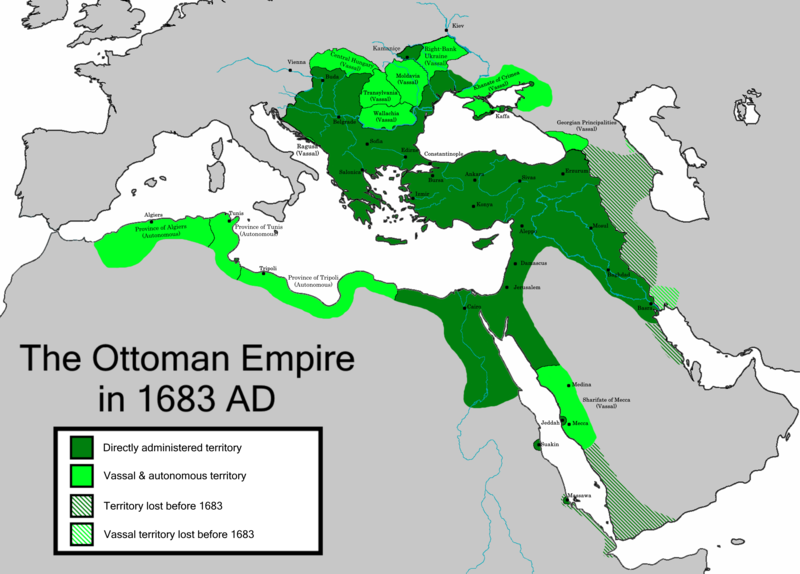
Ottoman Empire timeline | At its peak, the Ottoman Empire spanned from Vienna in southeastearn Europe to the Balkan region, to Greece and places in Ukraine. Other modern-day North African countries like Algeria, and Middle Eastern countries like Iraq, Israel, and Syria were once part of the colossal empire as well.
Spanning virtually the entirety of Anatolia, eastern Europe, parts of North Africa, and western Asia, the Ottoman Empire was one of the greatest and largest empires in world history. The empire, which existed for more than 600 years, derived its name from its founder Osman I (1259-1326), a local Turkish prince from the tribe of Bithynia in Anatolia (Asia Minor).
Reaching its peak between the late 15th and early 16th centuries, the Empire began to steadily decline around the 18th century due to growing bureaucracy, divisive political factions, and endemic corruption among some top officials.
Once considered one of the most powerful empires in the world, the Ottoman Empire came to be tagged the “Sick man of Europe”. The rise of nationalist movements and powerful interests dealt it a huge blow following its humiliating defeat in World War I.
By the early 1920s, the empire had disintegrated and was partitioned, with many of its former territories becoming independent countries, including Serbia, Bulgaria, Kuwait, Bosnia and Herzegovina, and Albania. The Ottoman Sultanate, which was headquartered in Constantinople (present-day Istanbul), was abolished; the sultan fled; and modern-day Turkey was founded (in 1923) on the ashes of what was once a great empire.
Read about the major events that marked the rise and fall of the Ottoman Empire, one of the world’s greatest empires, which struck a heavy blow to the Eastern Roman Empire headquartered in Constantinople (modern-day Istanbul, Turkey).
Origins and early years

The name of the Ottoman Empire came from the nomadic Turkmen chief called Osman I (known in Arabic as ʿUthmān). Sultan Osman I is regarded as the founder of the Ottoman dynasty (House of Osman) in the late part of the 13th century. Osman was the head of the House of Osman. | Image: 19th-century depiction of Osman, by Konstantin Kapıdağlı
Before 1060: The Seljuk dynasty (which mainly comprised of Kayi tribe and Turkmen Oğuz nomads from Central Asia) enter Iran, Mesopotamia and some parts of Anatolia.
1071: The Seljuks inflict a humiliating defeat on the Byzantine Empire at the Battle Manzikert as well as in subsequent battles that follow.
Early 1100s: Seljuks establish a strong foothold in eastern and central Anatolia (i.e. Asia Minor).
1200s: The Seljuk dynasty is battered by the Mongol invasions; gradually they lose their influence in the region as independent Turkic tribes begin to war with each other for regional dominance.
1293: Defeat of the Seljuks by the Mongols allows one of the Turkic tribes centered in Söğüt (modern-day Bilecik Province, midwest Turkey) to rise to prominence.
Mongol conquest and subsequent disintegration of the Seljuks
The Seljuks (of the Seljuk Sultanate of Rum), who were still reeling from the pain inflicted upon them by the Mongol invasions, quickly capitulated to the might of Osman I and his raiders. Similarly, the Byzantine Empire could hardly mount any solid defense to prevent its territories in present day central Turkey from falling into the hands of the Ottoman warriors.
Osman I (reign – c. 1299-1323/4), founder of the Ottoman Dynasty
Osman was an influential leader who not only led many fighters from a number of Anatolian tribes and principalities (beylik), but he was also able to get the support of people that were rejected by the Byzantine Empire. He even had some non-Muslims in his camp. Osman I also concentrated his raid efforts on the Byzantine territories from Bursa all the way to the Bosporus to the west.
Confident in the tactics of Osman I, many small nomadic tribes and vagrants in the Anatolian region joined the cause of the Osman. The severe internal turmoil in Byzantium, afforded Osman I and his Ottoman warriors the opportunity to claim more territories of the Byzantine Empire. An often discredited notion was that Osman I was able to inspire warriors to sacrifice everything on the field of battle in the name of Islam. Due to the absence of any surviving documentation pertaining to that issue, it remains unclear as to how Osman was able to bring the various Anatolian principalities together to fight against the Byzantine Empire.
1298: Osman I, a powerful chief of nomadic Turkmen from the region of Sogut, sets up the Ottoman dynasty. From his stronghold in western Anatolia (Asia Minor), he leads his Turkic warriors known as ghazi (“raiders”) to conquer Bithynia (in northwestern Anatolia) and other surrounding territories that were under the Seljuk dynasty at some point in the past.
1302: Osman leads his forces to victory against the Byzantine Empire at the Battle of Bapheus.
Did you know: The Arabic form of Osman I’s name is ʿUthmān, the same name that was given to the Ottoman Empire?
Ottoman Empire expands into the Balkans
The expanding Ottomans fought in many wars, including the Balkan-Ottoman wars and the Byzantine-Ottoman wars in the mid-14th and late 13th centuries respectively.
1324: Orhan, the son of founder Osman, succeeds his father. The new sultan accomplishes his father’s goal and completes the seizure of the city of Bursa from the Byzantine Empire. Orhan proceeds to make the city the capital of his state.
1331-1338: Several Byzantine towns in northwestern Anatolia fall into the hand of the Ottoman sultan; İznik in 1331; İzmit in 1337; and Üsküdar in 1338.
1345: The onset of Ottoman invasion of Europe via the Balkans.
1361: Murad I, the son of Orhan, follows in his predecessors’ footsteps and continues expanding Ottoman’s boundaries northward into Thrace and Adrianople.
1363: Murad I makes Adrianople, which he renames Edirne, the capital of the Ottoman Sultanate.

Muslim Moroccan explorer and scholar Ibn Battuta describes Orhan Ghazi, the second sultan (bey) of the Ottoman Beylik (i.e. Ottoman Empire) as “the greatest of the Turkmen kings and the richest in wealth, lands, and military forces”. | Image: a 16th century Ottoman miniature of Orhan Gazi, the second sultan of the Ottoman Empire
1387: Thessaloniki (in present day Greece) is seized and then sacked by the Ottomans from the Venetian Republic.
1389: Sultan Murad I (reign – 1362-1389) dies after defeating the Serbians, led by Prince Lazar Hrebeljanovic, at the Battle of Kosovo in June 1398. Murad was said to have been assassinated by a Serbian nobleman.
1396: The Bulgarian-Ottoman wars culminate in the Battle of Nicopolis, resulting in an Ottoman victory over the Bulgarian Tsardom of Vidin.
The Ottoman Interregnum, or the Ottoman Civil War (1402-1413)
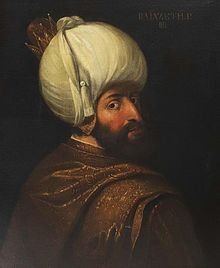
Sultan Bayezid I, the fourth sultan of the Ottoman Empire from 1389 to 1402, is famed for his victory against the Crusaders at Nicopolis (in present-day Bulgaria) in 1396. He died in 1403 while being held captive by Timur (1336 – 1405), founder of Timurid Empire. His death ushers in the The Ottoman Interregnum (the Ottoman Civil War), which lasts from 1402 to 1413. | Portrait of Bayezid I created in 1700-1800
1402: In the Battle of Ankara in July 1402, the Ottomans suffer defeat at the hand of Timur, the leader of the Timurid Empire.
1402: The Ottomans bad streak continues, as they lose areas such as Kosovo, Macedonia and Thessaloniki.
1403: Sultan Bayezid dies while being held captive by Timur, resulting in a civil war breaking out in the Ottoman Empire.
1403-1413: Following the defeat of the Ottomans and then the death of Sultan Bayezid I, a civil war known as the Fetret Devri breaks out in the Ottoman dynasty, pitting the sons of Bayezid against each other.
Reunification of the Ottoman state

5th Sultan of the Ottoman Empire Mehmed I (1389 – 26 May 1421), also known as “The Restorer”, is praised for reuniting the Ottoman state which had gone through an 11-year civil war (the Ottoman Interregnum). Like his predecessors, Mehmed I continued marching into Europe, taking Wallachia in 1415. He hit a brick wall when Venice destroyed his fleet off Gallipoli in 1416 | Mehmed I, miniature from a 16th-century manuscript illustrating the dynasty; in the Istanbul University Library, Istanbul (MS Yildiz 2653, fol. 261).
1413: Mehmed Çelebi, one of the sons of Bayezid I, comes out victorious, at which point, he becomes the fifth sultan of the Ottoman Empire.
1421: Mehmed I dies, and the throne is inherited by his son Murad II.
1430-1450: Sultan Murad II takes back territories, such as Kosovo, Macedonia and Thessaloniki, that had been lost.
1444: Under the leadership of Murad II, the Ottomans are able to drive back the Crusade of Varna at the Battle of Varna.
1448: Ottomans, under the leadership of Mehmed II (or Mehmed the Conqueror), defeat a Hungarian and Wallachian force led by John Hunyadi at the Second Battle of Kosovo.
Conquest of Constantinople and Further Expansion (1453-1520)
Ruling from his newly captured city, Constantinople, Mehmed II proceeds to establish a strong Ottoman government that steers the affairs of various territories in southeastern Europe and Anatolia. With the capture of several ports in Vienna, the Ottomans attain full control of the eastern Mediterranean.
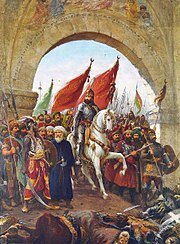
Ottoman Empire timeline | Between 1444 and 1481, the Ottomans go on a rampage, seizing large parts of Anatolia and southeastern Europe. The man behind those conquests was Mehmed II (reign – 1444-46 and 1451-81), seventh Sultan of the Ottoman Empire | Painting: Sultan Mehmed the Conqueror’s entry into Constantinople; painting by Fausto Zonaro (1854–1929)
1453: The heart and crown jewel of the Byzantine Empire, Constantinople, gets captured by Sultan Mehmed II.
1453: Mehmed II (the Conqueror), son of Murad II, brings down the Byzantine Empire with the capture of Constantinople.
1481: Bayezid II, son of Mehmed II, inherits the throne.
1512: Selim I (reign – 1512-1520), son of Bayezid II, becomes sultan after the latter’s abdication.
1512-20: Sultan Selim I makes massive improvement in the army and marches upon areas in Syria, Egypt and Arabia. Selim I is responsible for more than doubling the already vast Ottoman Empire.
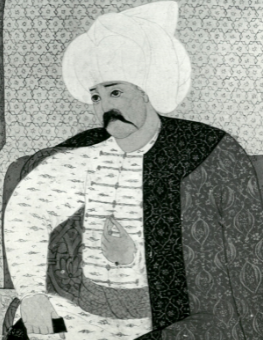
Selim I (1470-1520), also known as Selim the Grim, is most known for capturing lands that were previously under the Islamic Caliphate. Selim, being the most powerful person in the region at the time, establishes himself as the defender of Islam. This results in many Muslim scholars, artisans and artists thronging into the Ottoman capital Constantinople. He is popularly remembered as the first legitimate Ottoman Caliph. | Selim I, detail of a miniature, 16th century; in the Topkapı Palace Museum, Istanbul.
Did you know: At the time that Sultan Selim I died, the Ottoman Empire had reached a size of about 3,400,000 km2 (1,300,000 sq mi), having conquered (between 1516 and 1517) the entire Mamluk Sultanate of Egypt?
Reign of Süleyman the Magnificent (1520-1566)

Suleiman the Magnificent, known in his empire as Suleiman the Lawgiver, was famed for steering the Ottoman Empire to it peak in political power and influence on the global stage. In addition to building many mosques, bridges and other public infrastructures, Süleyman transformed the Ottoman navy into a fierce naval power in the region. The navy conquered North African cities like Algiers (in 1529) and Tripoli (in 1551). | Portrait of Suleiman by Titian c. 1530
Known in the Turkish language as Süleyman, Sultan Suleiman I (1494 – 1566) succeeded his father Selim I in September, 1520. This tenth Sultan of the Ottoman Empire reigned for 46 years, i.e. from 1520 to until his death in September 1566, making him the longest-reigning sultan of the Empire. He was known in his empire as Suleiman the Lawgiver.
Perhaps one of the most influential monarchs in modern history, Sultan Suleiman was the ruler of the Ottoman caliphate which had at least 24 million people under its rule. He turned his Ottoman army against many Christian nations in central Europe and the Mediterranean. There was no world power at the time that could rub shoulders with Suleiman when it came to the control of the seas from the Mediterranean to Red Sea and then to the Persian Gulf.
Aside from being one of the greatest conquerors of the modern era, Ottoman Sultan Suleiman the Magnificent was said to be a prominent reformer. He worked very hard with his chief judicial officer Ebussuud Efendi to institute many judicial reforms, as well as reforms in education and taxation. Sultan Suleiman is praised for merging two very different forms of Ottoman judicial systems – sultanic (Kanun) and religious (Sharia).
Did you know: Suleiman the Magnificent was not only a renowned poet and goldsmith; but he was also a respected admirer of culture and art?
Major Facts about Sultan Suleiman I
- His reign was characterized by tremendous growth of art, literature and architecture, i.e. the Golden Age of the Ottoman Empire.
- Going against established tradition, Suleiman I tied the knot an Orthodox Christian woman from his royal harem called Hürrem Sultan. The woman, who later converted to Islam, was popularly called Roxelana, due to her red hair.
- With his wife Hürrem Sultan, he gave birth to a son called Selim II, who succeeded him following his death in 1566.
- Suleiman’s three other sons and potential successors, Sehzade Mehmed, Sehzade Mustafa, and Sehzade Bayezid, died in very tragic circumstances. Mehmed succumbed to smallpox in 1543. Both Mustafa and Bayezid were killed at the order of Sultan Suleiman I. The former was strangled to death in 1553, while the latter was executed in 1561.
1520: Süleyman the Magnifient (Süleyman I) becomes ruler of the Ottomans. The sultan sets out to seize Belgrade (in today’s Serbia) a year after his sword girding (an enthronement ceremony of the sultans).
1521: Suleiman the Magnificent (reign: 1520-1566) captures Belgrade.
1522/23: The Island of Rhodes (in present day Greece) falls under the control of the Ottomans.
1526: The Ottomans secure victory in the Battle of Mohacs, allowing them to gain control in Central Europe.
1529: Süleyman the Magnificent cuts his siege to Vienna short due to the lack of supplies. He directs his military efforts against Persia (Iran). Ultimately, the Ottomans fail to take the city of Vienna during the Siege of Vienna.
1535: Baghdad falls into the hands of the Ottomans.
1543: The Ottomans and France form an alliance to take Nice.
1553: The Franco-Ottoman alliance conquers Corsica.
1550s: Famous Ottoman architect/scholar leads a team to build the Mosque of Süleyman, one of the most iconic (even to this day) buildings of the Ottoman Empire.
1566: Ottoman Sultan Suleiman the Magnificent dies. He is succeeded by his son Selim II.

In the 1550s, famous Ottoman architect/scholar Mimar Sinan (also known as Koca Mi’mâr Sinân Âğâ) leads a team of architects and engineers to build the Mosque of Süleyman, one of the most iconic (even to this day) buildings of the Ottoman Empire. |Image: Mosque of Süleyman, built in the mid-16th century, Istanbul.
Era of Transformation (c. 1550-1700)

The Era of Transformation in Ottoman history refers to a period of crisis and adaptation and then transformation.
Towards the final few years of Sultan Suleiman I’s rule, the Ottoman Empire is said to have entered into an era called the Transformation of the Ottoman Empire. This era, which lasted from around 1550 to 1700, witnessed tremendous change in the political, economic, institutional, and legal landscape of the empire. The Ottoman sultans that reigned during this period tried to steer the empire from one of expansion and territorial conquest to one with strong bureaucratic governance. The policy adopted reinforced the Ottoman sultan’s role as the protector of Sunni Islam and enforcer of justice in the Muslim world.
Militarily, the Ottoman rulers knew that the empire needed to reform its military apparatus to make it more capable of handling the threat posed by the local warlords during the Celali rebellions. The Empire also had to contend with European opponents such as the Habsburgs from Austria and the Safavids in Persia. During the Era of Transformation (c. 1550-1700), the size of government increased about fourfold in order to rake in more revenues.
Many historians argue that the Ottoman Empire adopted those changes because it was grappling with numerous political and economic problems. Those reforms, particularly in the military and political establishments, to tackle the rising inflation and its mounting debt. Although the empire experienced increased divisions and factions in its internal politics, the sultans of this era were still able to keep the empire thriving, economically and politically. There were some gains made in women rights, as the women in the imperial harem began having a say in government.
For great parts of the 17th century, Ottoman rulers and important heads of political factions locked horns over control of the government. The Ottoman sultan’s power was significantly clipped by those judicial changes. The period also witnessed the rise and fall in influence (the Köprülü Era – 1656-1703) of the Köprülü family, which produced many grand viziers for the empire.
1571: Crimean and Turkish army burn Moscow.
1571: At the Battle of Lepanto in October 1571, Spanish and Venetian alliance secure a victory over the Ottomans.
1573: A peace treaty is signed between the Ottomans and Venice.
1617: Sultan Ahmed I, the Ottoman monarch who built the Blue Mosque (the Sultan Ahmed Mosque), dies.
1617: Ahmed I’s younger brother Şehzade Mustafa rises to the throne as Sultan Mustaf I.
1618: Sultan Mustafa is deposed in a palace coup in favor of Osman II, the son of Sultan Ahmed I.
1622: After a four-year reign, Osman II is killed on May 20, 1622 during a Janissary uprising.
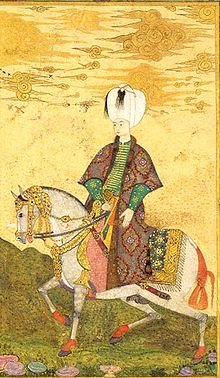
Osman II, son of Ahmed I, was strangled to death while held captive by the rebelling Janissaries in 1622 | Image: Osman II on horseback
1622-1623: Mustafa I’s second reign lasts until September 1623 when he is toppled by the Abaza rebellion (masterminded by governor-general of Erzurum, Abaza Mehmed Pasha).
1623: Murad IV, an 11-year-old son of deceased Sultan Ahmed I, becomes the sultan. His reign lasts for about 17 years, until 1640.
1623-1639: The Ottoman-Safavid War sees the Ottomans conquer Azerbaijan and the capture of Baghdad in 1638.

After his deposition, Sultan Ibrahim was strangled in 1648. His execution was even favored by his own mother Kösem Sultan. | Image: Sultan Ibrahim, the 18th Sultan of the Ottoman Empire
1640: Murad IV dies from cirrhosis in the capital Constantinople. He was aged 27. He is succeeded to throne by Ibrahim, his mentally (alleged) disabled brother, also known as “Deli Ibrahim”.
1647: A plot to depose Sultan Ibrahim is uncovered, and the chief plotter Grand Vizier Salih Pasha is executed.
1648: Sultan Ibrahim is overthrown in an uprising by the Janissaries in favor of his 6-year-old son Mehmed.
1648-1687: Sultan Mehmed IV’s reign of 39 years make him the second-longest reigning sultan in the history of the Ottoman Empire, after Suleiman the Magnificent.
1651: One of the most influential regents of the Ottoman Empire, Kösem Sultan, is assassinated.
1663: The Ottomans fail to take the city of Vienna during a siege.
1664: The Peace of Vasvár brings an end to the Austro-Turkish War (1663-1664).
1672: The Ottoman Empire attains its largest size in Europe following the end of the Polish-Ottoman War (1672-1676).
1683: Ottomans are defeated at the Battle of Vienna that sees the Ottoman Empire besiege the city of Vienna.
1683-1699: The War of the Holy League sees the Ottoman Empire lose its territories in Hungary (Ottoman Hungary) to the Habsburgs from Austria. The loss results in the rolling out of further administrative reforms, which in turn increases the level of bureaucracy in the empire.
1687: Mehmed IV is overthrown by aggrieved soldiers in favor of his brother Suleiman II.
1689: A Christian anti-Ottoman uprising called the Karposh’s Rebellion occurs in Ottoman Macedonia.
1697: The Ottoman Empire suffers defeat at the hands of the Holy League armies.
1699: Ottomans lose most of Hungry to Austria in the Treaty of Karlowitz.
Ottoman stagnation and reforms (1700-1876)
The start of the 18th century witnessed the gradual loss of Ottoman territories. Their decline is intensified by the inefficient nature as well as the corruption that are so rampant among top officials.
1699: The Ottoman Empire is unsuccessful in seizing the city of Vienna. The Ottoman sultan also pulls out of Hungary, marking the beginning of the decline of the Ottoman Empire.
1718: The Treaty of Passarowitz is signed between the Ottomans and the Habsburg Monarch and the Republic of Venice.
1718: The start of the Tulip Era (Turkish: Lâle Devri) sees the Ottoman Sultans orient themselves towards Europe.
1730: Sultan Ahmed III (reign – 1703-1730) is overthrown by mutinous Janissaries under the leadership of Parona Halil. His nephew Mahmud I becomes the new sultan.
1839-1876: To halt the decline, Sultan Abdülmecid I (reigned – 1839-1861) and his successor Abdülaziz (reigned – 1861-1876) introduce a number of reforms.
Slight progress is made; however, Ottoman Empire’s decline continues due to its mounting financial problems, as well as the shortage of skilled workforce. The sultans face stiff opposition from conservatives and traditionalists who claim that those reforms go against the teachings of Islam. The Empire also faces huge political and economic sanctions from many European nations who describe the Ottoman Empire as the “sick man of Europe.”
1853-1856: The Crimean War pits Russia against an alliance of Ottoman Empire, the United Kingdom, France and Sardiia. The Treaty of Paris on March 30, 1856 brought the Crimean War to a conclusion.
Rise of nationalism and ultimate disintegration (1876-1918)
1876: Abdülhamid II is becomes the ruler of the Empire in 1876. No sooner had he become the sultan than did a political/military group called the Young Turks pile up pressure on the Sultan.
1909: Abdülhamid II, who for years was accused of being an authoritarian ruler, is deposed by the Young Turks.
1914: The Ottomans ally with Germany during World War I.
1918: World War I sees the Ottomans and their German allies defeated, causing many Turkish nationalist to rise against the Ottoman sultan.
1918: As part of the peace negotiations following the end of WWI, the Ottoman Empire is forced to give up many of its territories. Those submissions further enrage Turkish nationalists, one of them being Mustafa Kemal.
Abolition of the Ottoman Sultanate
1922: Unable to handle the pressure piled up on him, Sultan Mehmed VI, abandons his Topkapi palace and flees. By fleeing the empire, Mehmed VI becomes the last sultan of the Ottoman Empire.

Ottoman Empire timeline – Mehmed VI, the last Sultan of the Ottoman Empire, leaving the country after the abolition of the Ottoman sultanate, 17 November 1922
1923: From their hub in Ankara, Mustafa Kemal and his nationalist party proclaim the birth of Turkey. Kemal, who is later given the distinguished title Atatürk (“Father of the Turks”), becomes the first president of Turkey.
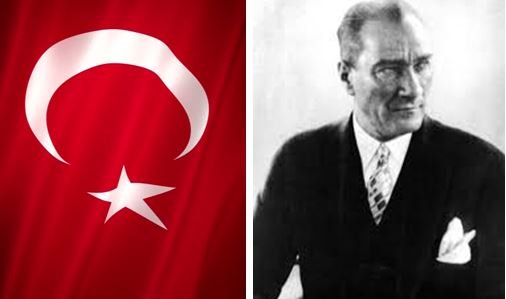
In 1923, the Turkish Republic was founded upon what was left of the Ottoman Empire, which had lost an enormous amount of territories in southeastern Europe, North Africa, and the Middle East | Image (L-R): Flag of the Republic of Turkey, and Mustafa Kemal Atatürk, founder of modern Turkey
More Ottoman Empire Facts

The Ottoman dynasty grew from a collection of small principalities (beylik) in Anatolia. Osman I, a prince from one of those powerful principalities, was able to bring many of principalities under his control before setting out to conquer many territories that under the control of the Eastern Roman Empire. | A Dutch map from 1635, referencing the “Turkish Empire” (TVRCICVM IMPERIVM)
- The use of Osmanlı or Türk was considered a demeaning name. A Türk often referred to a wandering peasant from an Anatolian tribe. Osmanlı was used to refer to members of the military or administrative top brass. It means followers of Osman, who was the founder of the Empire.
- The Ottoman Empire emerged from the Anatolian beylik, a small principality.
- The political, social, economic and legal structures of the Ottoman Empire emerged from blending the structures inherited from the Byzantine Empire and other great Turkish states in Central Asia.
- A literate in the early modern period (c. 1400 – c. 1800) preferred calling him/herself as a Rūmī, a name used to describe the inhabitant of the former Byzantine Empire, especially those in Anatolia and the Balkans.
- Historian like to refer to the period between 1533 and 1656 as the Sultanate of Women period, a period which sees two powerful women – Turhan Hatice (1627-1683), the Haseki Sultan (chief consort of an Ottoman Sultan) of Sultan Ibrahim I (reign – 1640-48), and Kösem Sultan (1589-1651) – emerge as powerful regents of the Ottoman Empire. In 1651, Kösem Sultan, who was the mother-in-law to Turhan Hatice, was assassinated.
- About a year into his reign, Suleiman the Magnificent conquered Belgrade. A year later, in 1523, the island of Rhodes fall into the hands of the Ottomans. And in August 1526, Suleiman’s army forced Hungry into submission. During his reign, the Ottoman Empire reached its zenith in terms of military, economic and political power.
- For quite some time, the 17th century was seen as a period of decline for the Ottoman Empire, however, modern historians tend to reject that notion, stating that the century was rather one of crisis, adaptation, and enormous changes across the board.
- The Ottomans had a tradition of royal fratricide, which is the act of killing one’s brother. It was legalized during the reign of Sultan Mehmed II. Bemoaning the devastation that was caused during the Ottoman Interregnum, which saw Mehmed I fight over the throne with his siblings Suleiman, Isa, and Musa, Mehmed II legalized royal fratricide. The goal was to avoid calamitous and costly civil wars by keeping the empire united and prosperous. Royal fratricide was made illegal during the reign of Ahmed I. Seniority was subsequently used in determining the members in line to the throne.
- Ottoman Empire Sultan Selim I, for example, is said to have killed two of his brothers – Ahmed and Korkut – after succeeding his father Bayezid II. The most shocking royal fratricide in the Ottoman Empire came when Mehmed III had 19 of his brothers and half-brothers killed.
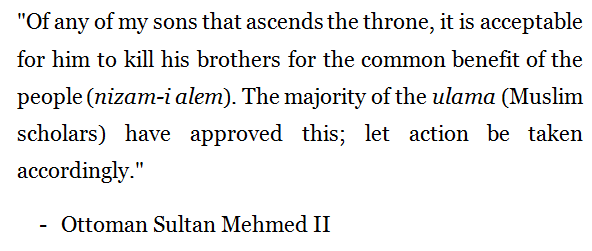
Mehmed II on fratricide in the Ottoman Empire


























